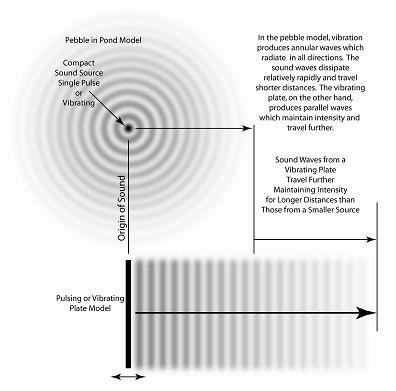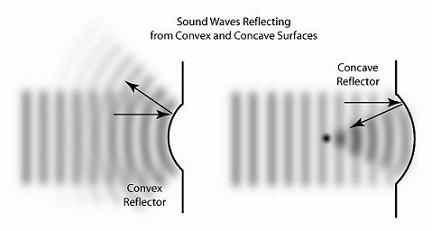In a preceding blog I explained how sound waves are produced by a vibrating or pulsing source. Today, I want to take a few minutes to talk about the way sound waves travel through a sound conducting medium and reflect from surfaces.

Many years ago in high school physics class, I was taught that sound waves were analogous to ripples in a pool of water diverging from the point where a pebble or rock was dropped. This analogy is appropriate for a relatively small sound source like a firecracker or the crack of a whip. The sound from these relatively small sources emanates in all directions equally and quickly dissipates. A vibrating surface with some dimension, however, produces waves that are more parallel in the way they propagate and may travel for longer distances. In a wave pool, for example, a huge wall at one end of the pool moves back and forth to produce waves that travel parallel to one another to the other end of the pool. As these waves approach the “shore” they become similar to ocean waves.
Sound waves, like light waves, reflect off surfaces. We are all familiar with echos. Echos are sound waves that, due to the fact that they have traveled to a remote sound reflector and returned, are heard after the primary sound from the source which travels directly to the listener.
In order for sound to be reflected it must encounter an abrupt change in density in the sound conducting environment. Sounds traveling through air (low density) which encounter a cement wall (high density) are efficiently reflected with very little sound being transmitted into the cement wall. The cement wall is a good reflector which, along with its weight, makes it a good sound barrier. A thin piece of lead (even more dense than concrete), however, is both a poor reflector and an effective sound barrier. Although relatively light in weight, the thin sheet of lead has “dead” physical properties which accept and absorb sound waves.
So, sound waves are reflected more strongly and accurately by some surfaces than they are by others. Just as a mirror reflects light better than a black piece of cardboard, sound waves are better reflected by a cement wall than they are by a curtain of fabric. The reflective environment for sound in a church or concert hall determines what performers call the “acoustics” of the chamber. Architects have been concerned with and adjusting the acoustics of auditoriums and other rooms for thousands of years. On studying some of the ancient churches in Europe and elsewhere, it appears that the architects, even though they didn’t yet understand what sound was all about, were able to (apparently through experimentation) create surfaces that selectively reflected different frequencies of sounds (reverberations or echos) to produce the desired acoustic properties long before microphones and loudspeakers and equalizers were invented. The ability to produce a surface that selectively reflects sound waves is analogous to painting a wall. The paint selectively reflects light waves of specific wavelengths. The texture and topography of the wall determines the way it reflects sound.
Much like light waves, sound waves can be focused and concentrated. A concave surface will concentrate sound waves by reflecting them to a common point while a convex surface will disburse sound waves by reflecting them in opposite directions. The following illustration shows these effects.

In the wave pool mentioned earlier, a third dimension is added which is depth. As the “waves” approach the shore, they are “amplified” or “concentrated” by the decreasing depth of the pool as the wave approaches the “shore.” The “ear horn” used by our hard-of-hearing great-great-grandparents is another device that was used to concentrate sound. Loudspeaker systems use the same technology to shape and concentrate sound – did you ever hear a Bose Acoustic Wave radio? That phenomenal sound is produced by manipulating the sound waves in a series of ducts buried in the plastic housing of the radio.
The thoughts above may seem interesting but not obviously relavant to the discussion of ultrasound. In fact, they are relavant. Understanding reflection, absorbtion and concentration of sound can be very valuable in understanding many sound phenomena including those crital to effective ultrasonic cleaning. Take the above for what they’re worth for now – I’ll show you how they relate as we proceed in the blog.
– FJF –



 English
English Spanish
Spanish Chinese
Chinese Canada
Canada Mexico
Mexico United Kingdom
United Kingdom



